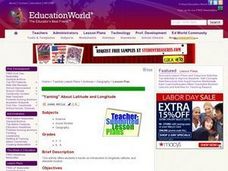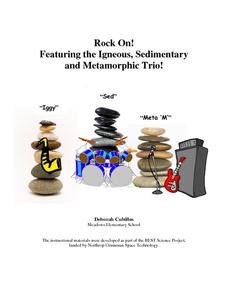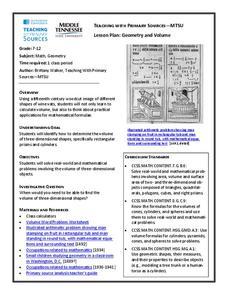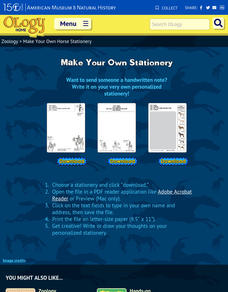Curated OER
"Yarning" About Latitude and Longitude
Students identify various locations using latitude and longitude. In this map skills lesson, students use yarn and labels to create a "human globe." Students identify the Prime Meridian, the Equator, and Northern and Southern Hemisphere.
Curated OER
What is the Evidence for Evolution?
Learners identify one object that would tell the story of their lives. In groups, they determine what can and cannot be told from objects left behind. After watching a video, they compare and contrast chicken bones to human bones. To...
Curated OER
You and the Law -- Beating the Odds
Students examine the rate of institutional racism in the United States. Individually, they write in their journals about how they can make better choices and increase their self-esteem. Using historical documents, they identify the...
Curated OER
Transportation in Indiana
Fourth graders investigate Indiana transportation. In this transportation lesson plan students discover early forms of transportation such as railroads, rivers, boats, and roads. Students compare and contrast the different forms of...
Curated OER
Agriculture Counts
Students practice counting. In this early numbers instructional activity, students learn about the beginnings of agriculture and how it ties into math. Students practice counting objects related to agriculture.
Curated OER
Life in a Drop of Pond Water
Young scholars investigate living creatures that inhabit a pond and explore how various organisms satisfy their needs within their environments. In this life in a drop of pond water lesson, students examine microorganisms under...
Curated OER
Happiness is a Warm Puppy
Students view the film "Dogs: The Early Years" from PBS then participate in different activities revolving around dogs. After researching different breeds, students select a dog that best fits their personality and living situation as...
Curated OER
Good Apples
Learners choose an apple from a larger group of apples and examine it closely. They return their apples to the group and then attempt to identify their own. They discuss how this activity applies to human similarities and differences.
Curated OER
Visit the Dome of the Rock
Students research the aspects of Dome of the Rock. They investigate the Noble Sanctuary, architectural features of the Dome of the Rock and the early Moslem Age.
Curated OER
Early Humankind and the Development of Human Societies
Learners examine archaeological studies to gather information on the physcial and cultural development of humankind. Using that information, they describe hunter-gatherer societies and how they developed tools and fire. Using maps,...
Curated OER
America's Civil Rights Movement, Activity Two
Young scholars investigate the human stories or the American Civil Rights Movement.
American Psychological Association
Developing Adolescents
Why to young people act the way they do? Scholars investigate the stages of adolescent development incorporating high school psychology techniques. Using research from the American Psychological Association, they uncover the five areas...
K12 Reader
From Nomad to Farmer
The gradual evolution of the earliest settlers in North America from nomads to farmers is the subject of a reading comprehension learning exercise that asks kids to answer a series of questions using information provided in the reading...
American Museum of Natural History
Microbes Coloring Book and Scavenger Hunt
Coloring pages showcase microbes—bacteria, viruses, and protists. Scholars have the option to download a coloring book and scavenger hunt or color the page directly on the computer. Three paragraphs describe each microbe.
Teach Engineering
Will It Fly?
Go fly a kite, then fly a plane! The 19th part of a 22-part unit on aviation looks at the way kites and gliders help aid in the understanding of flight. Pupils discuss how engineers used kites to influence airplane designs.
Curated OER
Rock On! Featuring the Igneous, Sedimentary and Metamorphic Trio!
Get your classroom rocking with this four-lesson earth science unit. Through a series of shared reading activities and hands-on investigations, young geologists learn about the three types of rocks and the unique properties of each.
Virginia Department of Education
Geometry and Volume
The history of math is fascinating! Utilize a woodcut primary source image from 1492 and posters from the 1930s to help geometers apply their volume-calculation skills to real-life questions.
Brilliant Publications
Daedalus and Icarus
The cautionary tale of Daedalus and Icarus is the core text for a series reading comprehension exercises based on the myth.
Art Authority
Art Authority K-12
Image field trips to museums that display over 1000 major works of western art. Imagine no airfare, no long lines, and only one admission fee. Imagine viewing at your convenience, with your own private docent providing information about...
Consortium for Ocean Science Exploration and Engagement (COSEE)
Climate Change Impacts on Blue King Crabs
Carbon dioxide is not only causing global temperatures to increase, it causes the oceans to become more acidic. Lesson focuses on the blue king crab and the fragility of the habitat due to climate change. Scholars create a concept map...
University of Minnesota
Sheep Brain Dissection
Bored with frog and earthworm dissections? Had your fill of fetal pigs? Anatomy students will be intrigued by the sheep's brain, and you will be prepared with guiding questions, extension activities, and pictures as they dissect one —...
Serendip
Structure and Function of Cells, Organs and Organ Systems
Cells of different organs have unique cell functions. Learn how cell functions vary depending on their roles in the body using an inquiry-based activity. Scholars analyze the cell structure to make comparisons to its functions, allowing...
American Museum of Natural History
Make Your Own Horse Stationary
Write a letter on horse-themed stationery. Three pages to choose from showcase a variety of horses and the history of horseback riding.
Curated OER
The African Burial Ground
Students analyze African American burial grounds. In this African American history lesson, students draw conclusions about African American communities in early New York and consider how archeology made it possible to study the communities.
Other popular searches
- Timeline of Early Man
- Early Man Neanderthal
- Time Line of Early Man
- Powerpoint Early Man
- Cultures of Early Humans
- History Early Man
- Social Studies Early Humans
- Early Humans Wanted Poster
- Early Man Rock Art
- Early Humans Africa
- Early Man Africa
- Timelines of Early Man

























